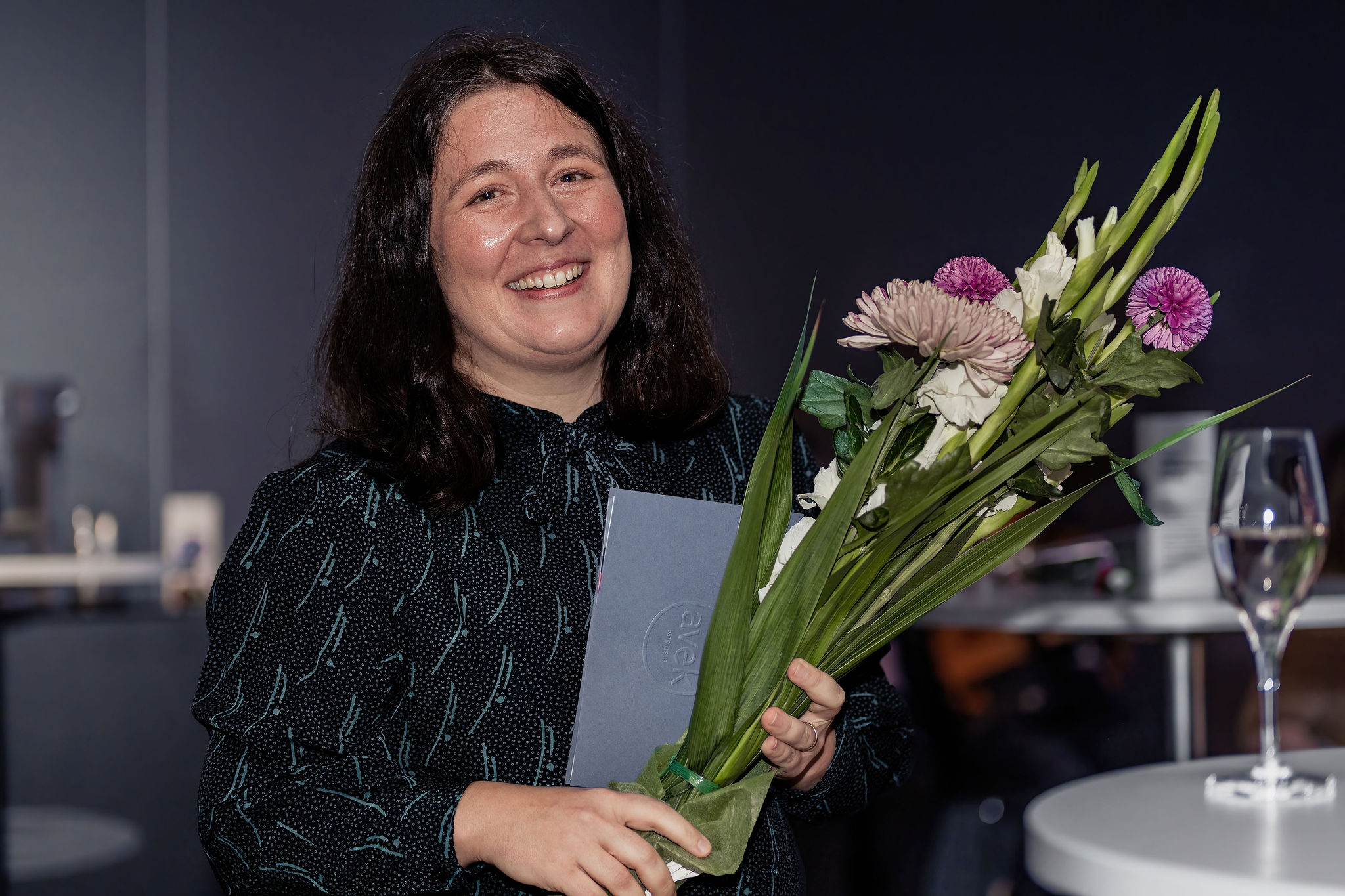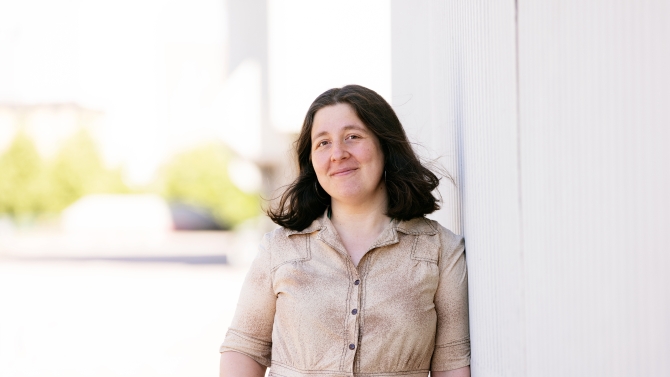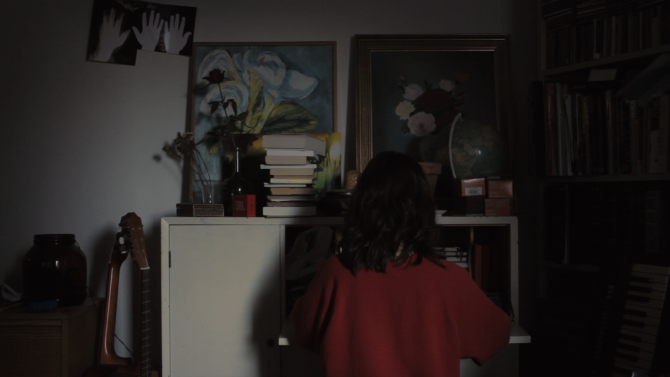
Thank you. Thank you to the jury, those who nominated me for the award and AVEK. I am very happy and honoured to receive this award. While the desire and opportunity to create art are the reasons for my work, I obviously hope that the works I have been involved in creating will speak to people, and that they will evoke a sense of recognition, provoke thoughts and also give pleasure. That is why this award feels good for me personally – something has been seen and recognised.
At the same time, I think that just as important as recognising things, is noticing that you do not recognise something. It is a particularly wonderful moment when the familiar and obvious begins to feel foreign, strange and incomprehensible – when, for example, words in our own language sound foreign, or when the order of a school classroom begins to resemble a clumsy film set. In such moments, I feel connected to this world. We are all strange, new and visiting here. We are not complete, whole or pure. Nor are we alone.
The video works, Laila’s Apple and My Home, which we watched here at the award ceremony, are part of a continuum in which I have tried to remember my childhood and asked others to remember theirs with me. At the same time, I have read about educational theory from different decades, spent time watching digitised television archives, browsed Wikipedia and read texts on language learning. It has been a slowly unfolding process, at the beginning of which I did not know what was going to come out of it. This process is still continuing.
My interest in these things is not just an artist’s interest in her subject. I am drawn towards these things. I end up near them even when I am not creating art about the topic.
I think what it means to be born into this world, grow up and learn the world. The boundaries of things are unclear. I am inside them. My own relationship with them is sticky (I am a child, I am an adult, I am a parent) and my memory is incomplete. The words I have do not reach to remember. Our collective memory is also lacking. Only part of our shared history remains, and it has been written from different perspectives at different times. Not everyone’s childhood has been written down as a story.
I looked through my notes on the making of Laila’s Apple and My Home to see if there was anything along the way that I could read out loud now. I chose this:
“The clip had stuck in my mind after I had seen it in the Yle archives about five years earlier. There was nothing special in it. A class of children and a teacher. A grey image. For some reason, the first time I looked at it, I thought the children were about nine years old, even though the events in the picture indicated that the children were in the first grade. They raised their hands, stood up to give their answers and then sat back down at their desks. At times, they walked to the blackboard, where they used the pointer given to them by the teacher to spell out the words on the board: Laila’s apple.
I thought: What am I looking at? There is nothing special here to see. Trees are swaying in front of the window. The same choreography repeats itself. Otherwise, there are only guesses and hints. A girl sitting in the classroom may be tired. It may also be shyness or irritation, an unwillingness to be in the picture.
Among all the television programmes on school and childhood produced to the last detail, this one stood out. An explanatory narrator was missing from this short clip, and the information on its index card was incomplete. But there was also something else missing. The final culmination. A climax. A full story. So, in the beginning there was a picture. The words came later.”
My works often have a narrator, words, sentences. Yet distrust and prejudice towards words, language and stories that are told too smoothly are definitely among the reasons I still make art. I become inspired again and again by their ability and inability to tell when using words.
And this same thing happens with pictures. I stare at pictures, get stuck on a detail. I keep coming back to the same picture. I try to understand it. I try not to understand.
Our collective memory is lacking. Only part of our shared history remains, and it has been written from different perspectives at different times. Not everyone’s childhood has been written down as a story.
Making art, for me at least, is an opportunity to play, to explore, to do things the wrong way, to look towards the inconsequential or irrelevant, the useless, to connect things that are not meant to be connected, while creating something that has a logic of its own. It is constantly being a newcomer in this world.
And it also reminds me that there are things in this world, the value of which cannot be measured in terms of money or anything else. Things that are valuable, interesting and beautiful just because they are.
I understand why people want to measure the benefits of art, but one of the most beautiful, even political, dimensions of art is its uselessness. The fact that art does not have to be a tool for anything. It can and may be, of course, but it does not have to be.
What do we want? What direction will our life force take? This question has stuck in my mind from a speech given by Philosopher and Professor of Education Veli-Matti Värri at the Media Education Forum in 2018.
He talked about education during the environmental crisis and said something along the lines that the reason why we, despite of our scientific knowledge, are acting against this knowledge (for example, increasing emissions, not reducing our consumption) is not because we have too little knowledge or because we do not understand this knowledge. It is because the scientific knowledge is at odds with what we want and desire.
“We are born into this world as sensual, bodily beings, reaching out to each other. The direction our desire, our life force takes is largely the result of socialisation. It is about what we learn to want: What kind of a life or life story is desirable and good? What kinds of things does it involve? What efforts will it take to achieve it?” This is somewhat how I remember Värri putting it.
The story of individual success through hard individual work, efficiency and control of one’s own body’s needs and desires is so ingrained in us that it is difficult to access. I can recognise this story speaking within myself as well.
In addition to this, the work of an artist is often lonely. Yet, like science, I see art as something collective, growing out of shared experiences and thinking. Shared by all, owned by no one, taking different forms in different places and at different times.
I believe that the best way to give good ground for this collective thinking is to support the possibilities in the whole profession, which consists of us individual artists, to make a living with creating art, work long-term, and also sometimes when needed take sick leave, heal and recover.
My own work often starts with archival material – images, words and sounds that are not my own. I think of the presence of these things that belong to others in my works as a kind of dialogue.
My works are also created in collaboration. The members of the working group bring their own skills, thinking and experience to the works. My loved ones are also often involved in the process. Laila’s Apple and My Home were created together with Kirsi Korhonen, Kaino Wennerstrand, Mariliis Rebane, Joonas Kiviharju, Aran Saiyar, Dunja Saiyar and Anna Ruth. There were also several stages of work that I did not do myself, from scanning the film to translating the works, making the poster, mixing and distributing the works.
I want to say thank you to all you dear people with whom I have had the pleasure of creating art. Thank you, my dear family, friends and colleagues: I am delighted by all the ways in which these categories mix! Thank you also for all the other support I have received and for the work that has been done for my works.
Finally, I would like to congratulate the 35-year-old AVEK, whose support for media art and film is invaluable.


